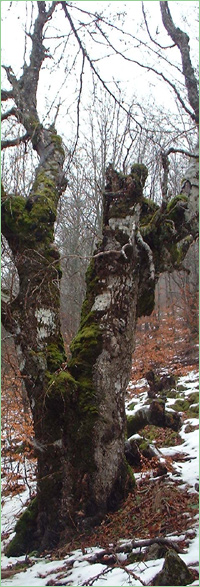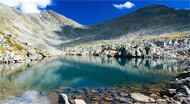Sreden Pirin - Alibotush (Unique identification code in the register: BG0001028)
Category: PZ under the Habitat Directive
Area: 68934.38 hectares Location:
1.
District: Blagoevgrad, Municipality: Gotse Delchev, Locality: Delchevo, Dobrotino, Dragostin, Gotse Delchev, Kornitsa, Lazhnitsa, Musomishta, Sredna
2.
District: Blagoevgrad, Municipality: Hadzhidimovo, Locality: Gaytaninovo, Ilinden, Koprivlen, Laki, Nova Lovcha, Novo Leski, Paril, Teshovo
3.
District: Blagoevgrad, Municipality: Petrich, Locality: Dolno Spanchevo
4.
District: Blagoevgrad, Municipality: Sandanski, Locality: Belyovo, Bozhdovo, Chereshnitsa, Debrene, Doleni, Dzhigurovo, Golem Tsalim, Goleshovo, Gorna Sushitsa, Gorno Spanchevo, Harsovo, Hotovo, Hrasna, Kalimantsi, Karlanovo, Kashina, Katuntsi, Kovachevo, Laskarevo, Lehovo, Lilyanovo, Lozenitsa, Lyubovishte, Malki Tsalim, Melnik, Novo Hodzhovo, Petrovo, Piperitsa, Pirin, Ploski, Polenitsa, Rozhen, Sandanski, Sugarevo, Vihren, Vinogradi, Vranya, Yanovo, Zlatolist, Zornitsa
Falls in the territory of the following Regional Inspectorates of Environment and Water (RIEW):
Blagoevgrad - ul."Svoboda" № 1
Ordinance for announcement:
Ordinance No.РД-350 from 31.03.2021
2-2-1028-350-2021
Ordinance for change:
Change in the area - increase with Decision No.811 from 16.11.2010
Record for protected zone (link):

Aims of the declaration:
1. Preservation and maintenance of the types of natural habitats specified in item 2.1, the habitats of the species specified in item 2.2, their populations and distribution within the boundaries of the zone, to achieve and maintain their favorable nature conservation status in the relevant biogeographical regions;
2. Increase the contribution of the protected area to the area of natural habitats with codes 5210, 6210 (* important orchid habitats), 6220*, 6520 in both biogeographical regions and of natural habitats with codes 4070* and 7230 in the part of the protected area falling within the Alpine biogeographical region;
3. Improving the structure and functions of natural habitats with codes 6210 (* important orchid habitats), 6220*, 62A0, 6520, 8110, 91E0* and 91M0 in both biogeographical regions;
4. Improving the structure and functions of natural habitats with codes 6170, 6230*, 62D0, 7230, 9180*, 91BA, 91CA, 9260 in the part of the protected zone falling within the Alpine biogeographical region and of natural habitat code 6510 in the part of the protected zone falling within the Continental biogeographical region;
5. Improvement of the habitats of the species Emys orbicularis in both biogeographical regions;
6. Improvement of the habitats of the species Dactylorhiza kalopissii and SGladiolus palustris in the part of the protected zone falling within the Alpine biogeographical region and of the Triturus karelinii, Elaphe quatuorlineata and Elaphe situla in the part of the protected zone falling within the Continental biogeographical region;
7. If necessary, improving the condition or restoring the types of natural habitats specified in item 2.1, habitats of species specified in item 2.2 and their populations;
8. Maintaining the connectivity of the habitats of the conservation priority species Ursus arctos and Canis lupus.
Objects of protection (species or habitats):
1. Article 6, paragraph 1, section 1 from Biological Diversity Act: 3140 Hard oligo-mesotrophic waters with benthic vegetation of Chara;
3150 Natural eutrophic lakes with Magnopotamion or Hydrocharition;
4060 Alpine and Boreal heaths;
4070 * Bushes with Pinus mugo;
4090 Endemic oro-Mediterranean heaths with gorse;
40A0 * Subcontinental peri-Pannonic scrub;
5130 Juniperus communis formations on heaths or calcareous grasslands;
5210 Arborescent matorral with Juniperus spp. ;
6110 * Rupicolous calcareous or basophilic grasslands of the Alysso-Sedion albi;
6170 Alpine and subalpine calcareous grasslands
6210 Semi-natural dry grasslands and scrubland facies on calcareous substrates (Festuco-Brometalia) (*important orchid habitats);
6220 * Pseudo-steppe with grasses and annuals of the Thero-Brachypodietea;
6230 * Species-rich Nardus grasslands, on siliceous substrates in mountain areas;
62A0 Eastern sub-Mediterranean dry grasslands;
62D0 Oro-Moesian acidophilous grasslands;
6420 Mediterranean tall humid grasslands of the Molinio-Holoschoenion;
6430 Hydrophilous tall herb fringe communities of plains and of the montane to alpine levels;
6510 Lowland hay meadows;
6520 Mountain hay meadows;
7140 Transition mires and quaking bogs;
7220 * Petrifying springs with tufa formation (Cratoneurion);
7230 Alkaline fens;
8110 Siliceous scree of the montane to snow levels ;
8120 Calcareous and calcshist screes of the montane to alpine levels;
8210 Calcareous rocky slopes with chasmophytic vegetation;
8220 Siliceous rocky slopes with chasmophytic vegetation;
8230 Siliceous rock with pioneer vegetation of the Sedo-Scleranthion or Sedo albi-Veronicion dillenii;
8310 Caves not open to the public;
9110 Luzulo-Fagetum beech forests;
9130 Asperulo-Fagetum beech forests;
9150 Medio-European limestone beech forests of the (Cephalanthero-Fagion);
9170 Galio-Carpinetum oak-hornbeam forests;
9180 * Tilio-Acerion forests of slopes, screes and ravines;
91AA * Eastern white oak woods;
91BA Moesian silver fir forests;
91CA Rhodopide and Balkan Range Scots pine forests;
91E0 * Alluvial forests withAlnus glutinosa and Fraxinus excelsior (Alno-Pandion, Alnion incanae, Salicion albae);
91M0 Pannonian-Balkanic turkey oak-sessile oak forests;
91W0 Moesian beech forests;
9260 Castanea sativa woods;
9270 Hellenic beech forests with Abies borisii-regis;
92C0 i>Platanus orientalis woods;
9410 Acidophilous Picea forests of the montane to alpine levels (Vaccinio-Piceetea);
9530 * Submediterranean pine forests with endemic black pines;
95A0 High oro-Mediterranean pine forests;
2. Article 6, paragraph 1, section 2 from Biological Diversity Act: Mammals - (Ursus arctos), (Canis lupus), (Rupicapra rupicapra balcanica), (Vormela peregusna), (Lutra lutra), (Myotis myotis), (Myotis blythii), (Myotis bechsteinii), (Myotis emarginatus), (Rhinolophus ferrumequinum), (Rhinolophus hipposideros), (Rhinolophus euryale), (Miniopterus schreibersii), (Barbastella barbastellus);
Amphibians and reptiles - (Bombina variegata), (Triturus karelinii), (Triturus carnifex), (Elaphe quatuorlineata), (Elaphe situla), (Emys orbicularis), (Testudo graeca), (Testudo hermanni);
Fish - (Barbus cyclolepis);
Intervertebrates - (Austropotamobius torrentium), (Cerambyx cerdo), (Morimus funereus), (Lucanus cervus), (Rosalia alpina), (Osmoderma eremita), Cucujus cinnaberinus, (Paracaloptenus caloptenoides), (Euplagia (Callimorpha) quadripunctaria), (Polyommatus eroides), (Lycaena dispar), (Cordulegaster heros), (Ophiogomphus cecilia);
Plants - (Himantoglossum caprinum), (Centaurea immanuelis-loewii), (Viola delphinantha), (Dactylorhiza kalopissii), (Gladiolus palustris), Mannia triandra, Buxbaumia viridis.
Current prohibitions and regimes:
1. It is prohibited conducting races with motor vehicles outside the existing roads and the places regulated for that;
2. It is prohibited movement of motorcycles, ATVs, UTVs and buggies off existing roads in non-urban areas. The prohibition does not apply to routes for the movement of the listed motor vehicles determined on the basis of a normative act, as well as in case of disasters, emergencies and for carrying out fire-fighting, emergency, control and rescue activities;
3. It is prohibited the prospecting for minerals (construction and stone materials), creating new and expanding concession areas for extraction of minerals (construction and stone materials); prohibition does not apply in cases where the date of publication of the order in the "Official Gazette" has started a procedure for granting permits for prospecting and / or exploration and / or the concession for extraction under Subsurface Resources Act (SRA) and Concessions Act, or a procedure for their coordination under Chapter Six of the Law on environmental protection and / or art. 31 of the Biological Diversity Act or an application for registration of a commercial discovery;
4. It is prohibited to change the way of permanent use, plowing, afforestation and conversion into permanent plantations of meadows, pastures and grassland, when using agricultural lands as such;
5. It is prohibited to plow and afforest meadows, barren lands and other unforested forest territories within the boundaries of non-forest natural habitats under item 2.1 except in cases of proven need for protection against erosion and flood rain, as well as in cases of implementation of eligible plans, programs, projects or investment proposals approved in accordance with environmental legislation;
6. It is prohibited to remove landscape features (borders, vital single trees and groups of trees, traditional strips occupied by shrub and tree vegetation among lands under cultivation, protective forest belts, stone fences and hedges), when using agricultural land as such, except in cases to removal of invasive alien species of trees and shrubs;
7. It is prohibited the use of fertilizers, soil improvers, biologically active substances, nutrient substrates and plant protection products that do not meet the requirements of the Plant Protection Act;
8. It is prohibited the use of mineral fertilizers in meadows, pastures, grasslands, abandoned agricultural lands and forest areas, as well as plant protection products of professional category of use in these areas except for calamity, epiphytosis or the use of selective methods to combat invasive alien species;
9. It is prohibited to use of organic sludge from industrial and other waters and household waste for introduction into agricultural land without permission from the specialized bodies of the Ministry of Agriculture, Food and Forestry and when the concentration of heavy metals, metalloids and persistent organic pollutants in sludge exceeds background concentrations according to Annex № 1 of Ordinance № 3 of 2008 on the norms for permissible content of harmful substances in soils (SG, issue 71 of 2008);
10. It is prohibited to use of irrigation water that contains harmful substances and waste above the permissible norms;
11. It is prohibited burning of stubble, syllables, roadside strips and areas with dry and moisture-loving vegetation;
12. It is prohibited to make a fire, improvements, electrification, conduct of business and sports activities in the caves and caves' entrances, as well as to break, damage, to collect or to remove of rock and cave formations, and also to divide the cave's entrance or its individual galleries in a way that prevents passing of species subject to protection under item 2.2.1;
13. It is prohibited conducting speleological research during the breeding season of bats - from March 1 to June 30;
14. It is prohibited grazing of domestic animals in forest areas, which are designated for forests in the old age phase.
15. It is prohibited extraction of wood and biomass in forests in the old age phase, except in cases of damage of more than 50% of the area of the respective forest in the old age phase due to natural disasters and calamities; in old age forests, through which existing forest roads and other infrastructure objects pass, if proven necessary, felling of single dry, damaged, endangered or obstructing the safe movement of people and vehicles or the normal functioning of infrastructure objects trees is allowed;
16. It is prohibited construction of roads of second and higher class without ensuring the construction of appropriate green infrastructure for crossing of bears and other animals.
Overlapping (partial or full):
1.
Natural Monument: Melnishki Piramidi
2.
Natural Monument: Pirostiyata
3.
Protected Site: Lazhnitsa
4.
Protected Site: Pavlyova Padina
5.
Protected Site: Pirinsko lale
6.
Protected Site: Slavyanka
7.
Protected Site: Zhingov bryast
8.
Reserve: Ali Botush
9.
Reserve: Orelyak
10.
PZ under the Bird Directive: Melnishki piramidi
11.
PZ under the Bird Directive: Pirin bufer
12.
PZ under the Bird Directive: Slavyanka

|
|

|





